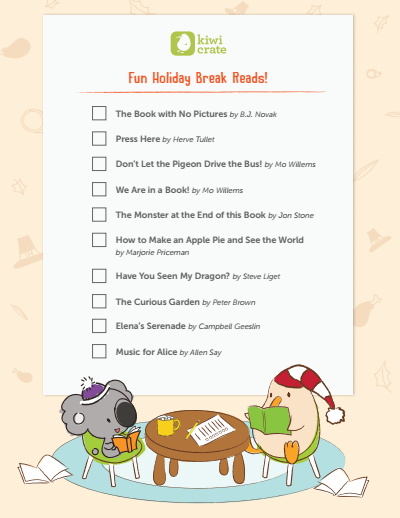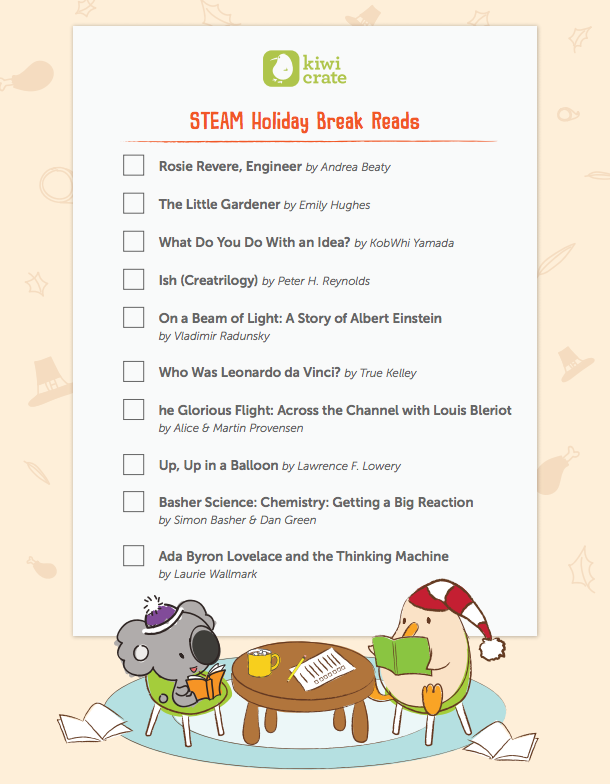Kids 3 to 4 years old:
- The Book with No Pictures by B.J. Novak
- Press Here by Herve Tullet
- Don’t Let the Pigeon Drive the Bus! by Mo Willems
- We Are in a Book! by Mo Willems
- The Monster at the End of this Book by Jon Stone
- How to Make an Apple Pie and See the World by Marjorie Priceman
- Have You Seen My Dragon? by Steve Liget
- The Curious Garden by Peter Brown
- Elena’s Serenade by Campbell Geeslin

Kids 5 to 8 years old:
- Rosie Revere, Engineer by Andrea Beaty
- The Little Gardener by Emily Hughes
- What Do You Do With an Idea? by Kobi Yamada
- Ish (Creatrilogy) by Peter H. Reynolds
- On a Beam of Light: A Story of Albert Einstein by Vladimir Radunsky
- Who Was Leonardo da Vinci? by True Kelley
- The Glorious Flight: Across the Channel with Louis Bleriot by Alice & Martin Provensen
- Up, Up in a Balloon by Lawrence F. Lowery
- Basher Science: Chemistry: Getting a Big Reaction by Simon Basher & Dan Green
- Ada Byron Lovelace and the Thinking Machine by Laurie Wallmark

Kids 9 to 16+ years old:
- An Epic Doodle (Stickman Odyssey, Book 1) by Christopher Ford
- Zita the Spacegirl by Ben Hatke
- Target Practice (Cleopatra in Space #1) by Mike Maihack
- Frank Einstein and the Antimatter Motor by Jon Scieszka
- Thing Explainer: Complicated Stuff in Simple Words by Randall Munroe
- A Wrinkle in Time: the Graphic Novel by Madeleine L’Engle
- The Case of the Missing Moonstone (The Wollstonecraft Detective Agency, Book 1) by Jordan Stratford
- You Wouldn’t Want to Live Without Electricity by Ian Graham
- The Evolution of Calpurnia Tate by Jacqueline Kelly
- Howtoons: Tools of Mass Construction by Saul Griffith

6 Tips for Getting Kids to Love Reading
We reached out to two awesome and invested teaching professionals for tips and tricks of the trade. Joan Kallas is the Library Media Specialist at Kenwood Elementary in Minneapolis, Minnesota. She has been teaching for 36 years. Loved and respected by her peers, Joan is known for her ability to keep her kids evolving their reading skills in tandem with new technology. Sabrina Strand is the English Department Chair for Junior High and Hight School English at Pinewood School in Los Altos, California. In her 12 year career, she has built a reputation for winning over her students’ hearts with her quick wit and devotion to their education.
- Schedule time to read as a family, and find a system for staying accountable.
- Switch between reading to your kids and having them read to you. If your child is too young to read, let them tell you a story from the pictures.
- Help your kids find books that connect to their real world experiences, or plan real world experiences that connect to their books. We do offer a Deluxe option for Koala Crate and Kiwi Crate subscribers that includes a specially curated book to complement the crate theme each month!
- Create an after reading routine. Talk about the book together and/or keep a reading journal for favorite passages, alternative endings, or cast lists.
- Plug into a community of readers, whether they are at the library or on fanfiction sites.
- Build a culture of reading and sharing stories at home. Practice what you preach by reading books yourself, consuming stories through podcasts, and engaging your kids in oral stories as well.
Share your tips and tricks for inspiring your kids to love reading in the comments below. We’d also love to hear what books your kids are reading! Read on for more tips from Joan and Sabrina.
How can I help my kids fall in love with reading?
Joan’s tips:
- Read aloud to them.
- Let them tell you the story, even if it’s just from the pictures.
- Let them pick the book, even if it’s the same one over and over. You can throw in a new book in-between readings.
- Take regular trips to the library, and make it a special affair. At the library, pick the books out together to get a good mix!
- A reading culture starts with you, let your kids see you reading. Try something that makes you laugh out loud. Show them reading is fun by example!
Sabrina’s tips:
- Read with your kids at the earliest age possible. Young children naturally love reading, and reading before bedtime is a great bonding ritual for the whole family.
- I see the light bulb go on for kids when the reading becomes personal for them. One family I know travels to the cities profiled in the historical fiction books their children read. They walk the same streets as the protagonists and visit the landmarks featured in the book. They also visit museums with mementos about the historical event. These are some of my most invested readers. Their parents have helped them to build a bridge from the books they read to the real world they live in.
- People who love stories love reading. Teach your kids that everyone has a story and that it’s worth asking about and listening to those stories. Listen to audiobooks as your kids help you cook; have podcasts playing on a lazy Sunday afternoon. Tell your kids stories about what you’re doing at work, a cause you’re passionate about, an interesting article you read, or radio piece you heard.
How can I encourage my kids to engage creatively with the books they read?
Joan’s tips:
- Talk to them about what they’re reading. Ask them questions. What do you think is going to happen? Why do you think so? What else could happen? What if this had happened in the story? Would it have ended differently?
- Try a simple activity like writing a new ending to the story. For younger kids especially, acting out or illustrating the part of the story and imagining a new ending can get kids to work though the details of the story.
Sabrina’s tips:
- Find fanfiction websites where they can discuss the book with peers from around the world.
- If they love to write, they can also write spinoffs or sequels and share them online on fanfiction sites or site like Wattpad (a popular place to read and share new stories).
- Encourage them to use a journal as they read. It’s a great place to respond intimately and creatively to their books. They can write down passages, sketch out scenes, record real life moments that reminded them of the book, or select a cast list for an imaginary movie production of the book.

